Baltic Sea tips: In the midst of unspoilt nature - 10 idyllic natural harbours
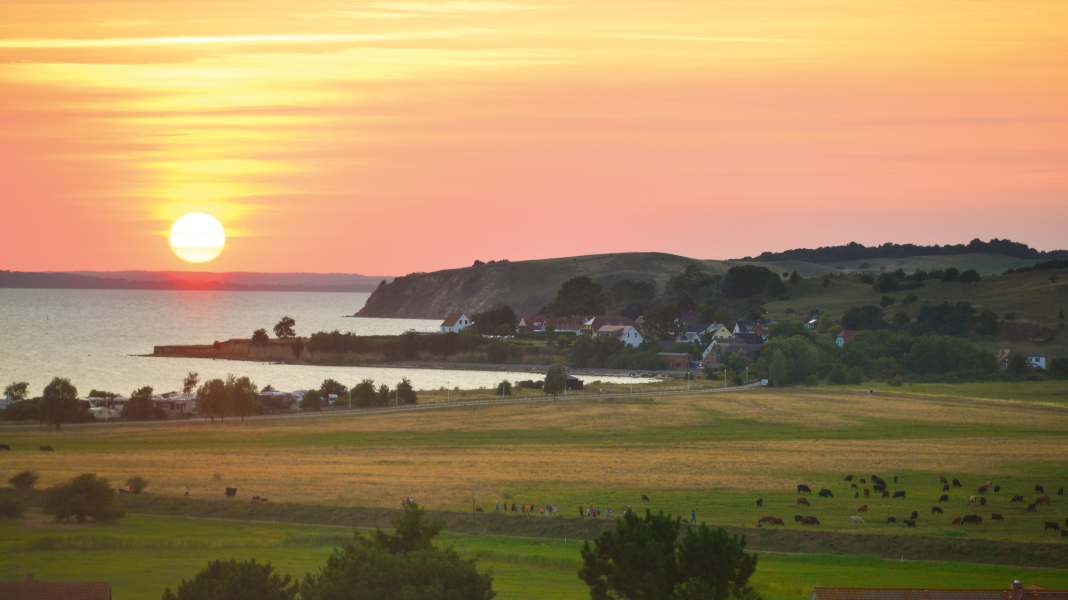
- 1st Mönchgut, Rügen - Green oasis on the doorstep
- 2. Æbelø, North Funen - Haven of peace in the Kattegat
- 3. Ærøskøbing, Ærø - A pearl in the centre of the Danish South Sea
- 4th Thurø Bund, Svenborgsund - in the old winter storage of the Svendborg schooners
- 5. Korshavn, north-east Funen - Anchoring in the primeval landscape
- 6. Wormshöfter Noor, Schlei - so close and yet felt so far away
- 7 Dyvig & Mjelsvig, Alsen - Legacy of the Ice Age: the almost perfect anchorage bay
- 8 Krummin, Usedom - Maritime gem in the far east
- 9th Helnæs Bugt, South Funen - Space even in the high season
- 10 Fifång, south of Stockholm - Protected jetty in the nature reserve
1st Mönchgut, Rügen - Green oasis on the doorstep
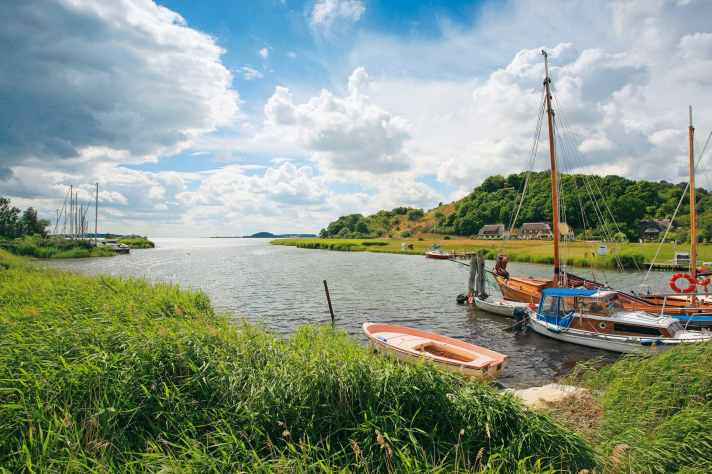
The south-eastern tip of the island of Rügen belonged to the Cistercian monastery of Eldena in the Middle Ages. The Mönchgut is a peninsula with several inlets on the south-western side facing the Greifswald Bodden and the Baltic Sea on the opposite side. The headlands in between are hilly and offer sweeping views of the sea and across the fjords and inland lakes from the cliffs. Six villages are easily accessible by boat: Seedorf, Baabe, Sellin, Gager, Klein Zicker and Thiessow.
The settlements are mostly characterised by the small thatched-roof houses of the fishermen. Most of them are now holiday flats. But despite the high level of tourism, they have retained much of their original character - apart from Baabe and Sellin, perhaps - and life there is quiet and leisurely. A good example of this is Gager, whose harbour is sheltered in the Hagenschen Wiek. Even the newly built holiday homes on the shore here are small and thatched. Restaurants invite you to give your gas cooker a break. And it is highly recommended to take a walk across the headland and let your gaze wander. On the other side is Groß Zicker, one of the oldest villages in the region, with a village church dating back to 1350 that is well worth seeing. The aforementioned Seedorf is also located at the northern end of a natural harbour. There is a small marina with a bar and smokehouse. Quality wines and Mediterranean cuisine or fish from the surrounding Bodden - as a guest, you have a free choice here.
Other attractions in this micro-region include the smallest Baltic Sea ferry, consisting of a wooden barge between Baabe and Moritzdorf, as well as the "Moritzburg", a restaurant in the village of the same name. It is considered a top address with a spectacular view of the Having, the westernmost of the Mönchguter Bodden. But it is not only on your own keel that you can reach worthwhile destinations. Middelhagen, in the centre of Mönchgut, can be reached quickly by bike. Or take the historic steam railway, the "Rasender Roland", to the Baltic seaside resort of Göhren. In short, anyone who appreciates small harbours and quiet anchorages can spend almost an entire summer holiday here.
2. Æbelø, North Funen - Haven of peace in the Kattegat
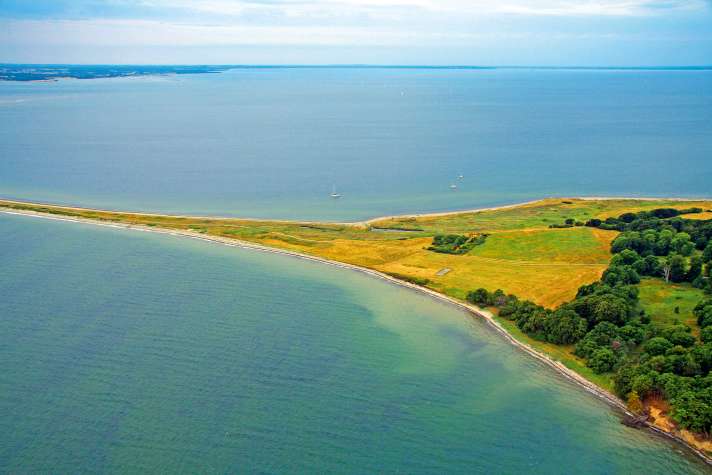
A light-coloured beach, a narrow headland. To the north a steep coast, behind it forest and the cap of the lighthouse. The uninhabited Æbelø forms a kind of double bay, divided by a thin strip of earth that disappears into the water to the south. The trees offer yachts good protection from the wind at anchor and they can go close inshore in almost all conditions. The island was once part of an estate and was used for hunting. That is a thing of the past; today deer and mouflons graze here undisturbed. If you're lucky, you might even spot rare white-tailed sea eagles here.
3. Ærøskøbing, Ærø - A pearl in the centre of the Danish South Sea
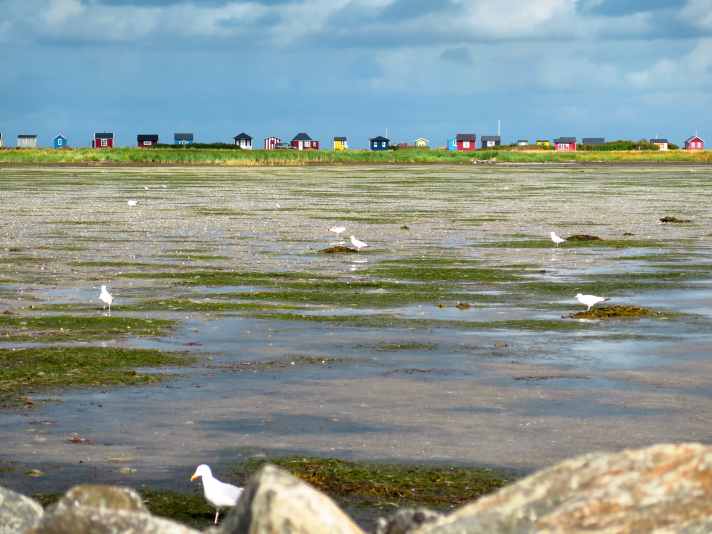
Anyone who has not yet visited the fairytale town in the centre of Ærø should definitely put it on their bucket list. It is said that Ærøskøbing is the best-preserved Danish town from the Middle Ages. In order to preserve its flair, the settlement, which was founded around 1250, is under strict monument protection, which regulates exactly what changes may be made to the crooked, colourful wooden houses and the narrow cobbled streets. Thanks to the large natural harbour, which is protected from all wind directions, Ærøskøbing can look back on an eventful past as a merchant metropolis and home port of a large merchant fleet. The cookhouse at the harbour is a reminder of this time. It was built in 1810 because cooking was not allowed on board the wooden ships for fear of fires.
The marina next door has modern facilities, but in the high season it can get crowded in the early afternoon. The main attractions include the museums that tell the story of the trading era, the Bottle Ship Museum and, of course, the picturesque backdrop of the bathhouses around Revkrog to the west of the town, where you can anchor in four metres of water.
The colourfully painted little houses on the shore are well over 100 years old and are never sold, but traditionally handed down from generation to generation. There is probably no better place on the island to enjoy the sunset than directly from the anchorage in front of the colourful stalls.
4th Thurø Bund, Svenborgsund - in the old winter storage of the Svendborg schooners
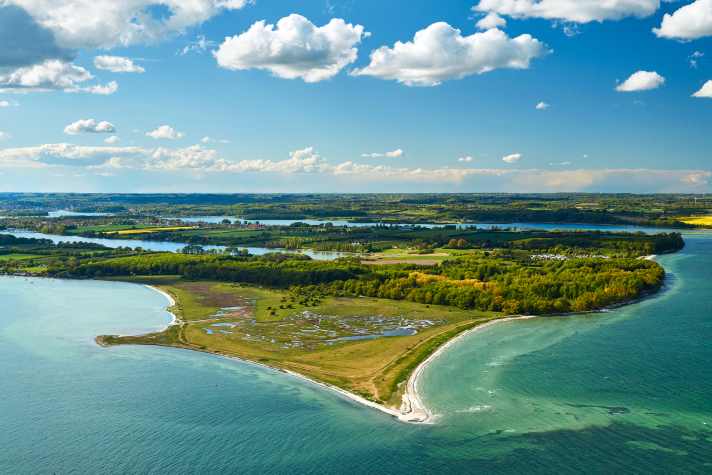
Centuries ago, the shipowners and captains' families of Svendborg and Troense used the perfectly sheltered anchorage in Svendborg Sound to moor their schooners. Up to 130 of the stately ships moored here, safe from the powerful winter storms, and were maintained in the shipyards on the northern shore of the bay. Proof of this is a large historical panoramic photo from the early 19th century, which hangs on one of the fishing sheds on the northern shore near Thurø Sailing Club.
Anyone entering the narrow entrance to the bay at the mini island of Kidholm today will immediately understand why: the bay, which is about a nautical mile deep, is embedded in the landscape, with dense deciduous forest on the southern shore and old farmsteads and houses on gently undulating grassland to the north. The bay is only open to the west, but even when it blows hard, the waves in Thurø are never dangerous, at most uncomfortable.
Most crews anchor here, the view of the forest and houses as well as some jetties on the shore is simply too beautiful. You sometimes have to be patient when manoeuvring the anchor, as the muddy ground with seaweed is very soft in places and the anchor doesn't always grab immediately. But once the iron holds, the boat is surrounded by a heavenly calm. At the entrance to the bay, sailing yachts pass by every minute during the season, but it remains quiet in Thurø Bund. If you like, you can go for a swim, even if the water here is often a little murky from the inflow of some streams and there are quite a lot of jellyfish swimming around in westerly winds.
Of course, you can also moor somewhere else. There is the beautiful Thurø Sailing Club, which has sensational barbecue areas on paved pitches under the huge oak trees on the hillside. The view over Svendborg Sound from there is simply marvellous with a sundowner in your hand. If the jetties there are full, the dockyard next door is an alternative. On land there is still a marvellously rotten, ancient fishing boat, a silent witness to better fishing days. There are also two jetties on the southern shore: the one to the west is open to guest moorers, although it is shallow in front of it. On land, there is a nice, albeit simple, barbecue area at the edge of the forest. Further inland in the bay, you will come across the Danish Scouts' jetty. In front of it, training dinghies race through the area in summer. Their accommodation is on the hill on land.
Thurø is visited by most cruising sailors because of its tranquillity and nature. But anyone who thinks there is nothing to do here is very much mistaken. One option is to land on the southern shore and walk to the shore in Grasten. This is where the historic Sund steamer "Helge" stops, which runs a shuttle service to Troense to Valdemars Slot, an old residence of a Danish king's son. The estate used to be open to visitors, but is now unfortunately closed. The lovingly restored ship also stops in tranquil Troense.
Last but not least, it is also relatively easy to get from Troense to Svendborg. This is a good alternative if, for example, Svendborg harbour is overcrowded in the high season and the yachts are lying there in dense rows. There are several bus stops at the top of the Thurø housing estate, up the road by the shipyard. The bus to Svendborg departs from there - a 20-minute journey. It's free and goes all the way to the centre. But perhaps you'd rather just enjoy the tranquillity of the bay.
5. Korshavn, north-east Funen - Anchoring in the primeval landscape
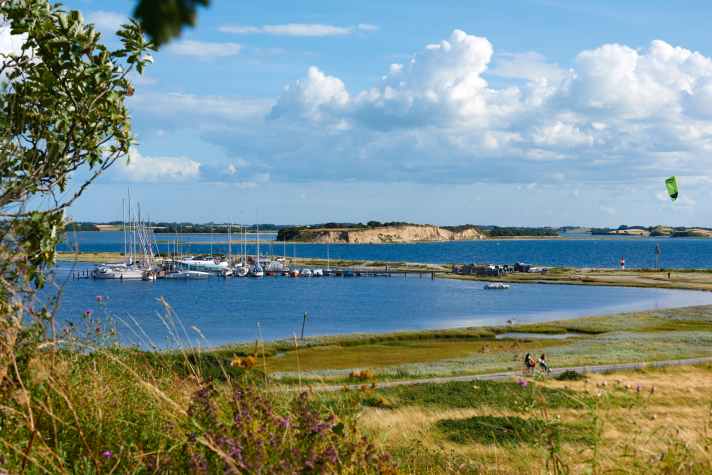
Every year in September, the beautiful, varied island of Funen, which is quite close to Germany, serves as a natural turning point, so to speak, in the world's largest single-handed race. Then 450 soloists - starting places are as limited as they are coveted - race non-stop the 143 nautical miles around the island between Jutland and Zealand. It is a special experience for the active participants, but with one serious disadvantage: they miss out on unique anchorages and harbours.
Like Korshavn. The name stands for a bay in the north-east of Funen, which is one of the most beautiful and popular anchorages in the kingdom and a logical stop between Kerteminde and Bogense or Endelave on the classic cruising route, the popular tour around Funen.
Even the approach, which is reasonably challenging due to a few shallows and stones, is a visual delight as you pass the steep banks, which are up to 25 metres high and well worth seeing. From a purely nautical point of view, Korshavn is quite well protected, as it is almost circular and blessed with a rather small entrance. It is open to the south-west and therefore in the direction of the prevailing winds, but a small headland keeps the waves at bay.
The moorable water area with depths of more than two metres is only 400 by 500 metres, so it can get a little crowded. But that doesn't bother anyone here in summer. The bottom is quite heterogeneous, with iron meeting clay, sand and seaweed. Two small jetties with a water depth of 1.80 metres are the alternative to anchoring for boats with a corresponding draught. The crews will also find electricity and water there.
There is very little development around the bay; you are among yourself and a few campers on the shore in a natural harbour. The harbour is bordered by small sandy beaches on the western edge, otherwise by some trees and a few weekend cottages. There are almost no facilities, apart from public toilets and a small supermarket at the campsite on the eastern shore. Unless you count the self-service shelf at the jetty, which stocks local produce such as fruit.
In addition to water sports activities, a walk to the viewpoint on the Fyns Hoved headland is a delightful experience, ideally combined with an extended picnic. The view of the islands of Endelave and Samsø, plus a sunset in the water without disturbing a land mass, is unrivalled.
On the short hike, the varied primeval landscape at Fyns Hoved with its partly dry lagoon landscape, the steep coast and the stone fields offers its very own visual attractions - and is the main reason for many visitors to make a stopover in Korshavn.
6. Wormshöfter Noor, Schlei - so close and yet felt so far away
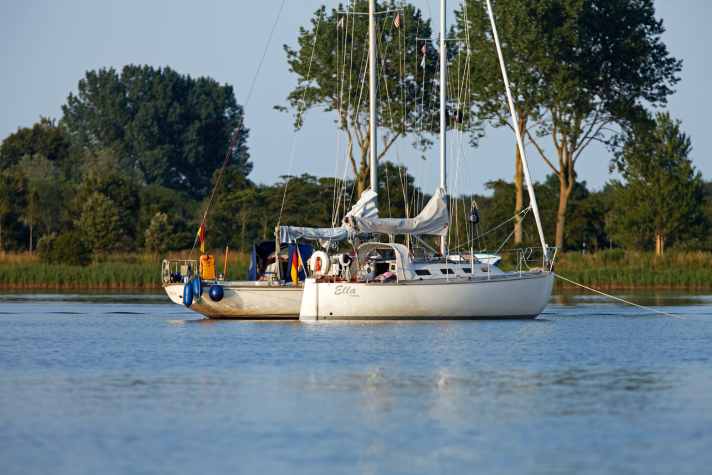
If you want to get in or out of the Schlei or are surprised by bad weather on the way out and are therefore looking for a quiet, scenic spot, this is the place for you. Even Wilfried Erdmann appreciated the Noor, which he often used as a place to "catch his breath" before or after his big trips. A place to let go or to wind down, well sheltered, except in strong southerly winds.
If you turn into the Noor in summer, when the Schlei's fairway often resembles a motorway, you will be surrounded by wonderful tranquillity after a few minutes. But be careful, there are two places in the entrance that are only 1.8 metres deep, and the western half of the entrance also quickly becomes shallow. So stick to the Maasholm side. Stakes with green markers guide you safely past the small harbour of the Modersitzki shipyard into the Noor. The harbour is a good alternative if you don't want to anchor. Yachts are often simply moored alongside on the outside.
However, the Noor is more popular as an anchorage, with dozens of yachts often moored here in the high season. It's best to feel your way in, on average the anchor drops to the bottom, which is just two metres deep - but you can rarely see it in the murky towed water. So keep an eye on the depth sounder. However, this is often deceptive, as the muddy bottom has a lot of vegetation and sometimes it shows less than is actually there. You don't need much chain here, the manoeuvre is usually done quickly. Then down the swim ladder and into the water or relax in the cockpit - marvellous!
Maasholm opposite offers a few restaurants for the evening, the popular fish sandwich snack bar at the harbour, a good bakery and a small supermarket. Fresh fish can be bought at the Petersen smokehouse or directly from the cutter at the harbour.
7 Dyvig & Mjelsvig, Alsen - Legacy of the Ice Age: the almost perfect anchorage bay

The glaciers have done a great job in the north of Alsen. The result is beautiful hills and deep cuts. One of these is Stegsvig. The real jewel is hidden behind its crest, where a narrow, slightly winding channel leads to Dyvig. The passage is marked with red and green stakes and is usually more than three metres deep. However, you should not stray out of it, as it is just knee-deep for seagulls right next to it!
Dyvig is probably the best sheltered anchorage in southern Denmark. The shore is lined with high hills and the opening is barely 50 metres wide, so wind direction and strength are of secondary importance. No matter which way the wind blows, you will always be calm here. The deep water reaches right up to the shore - perfect for anchoring, if only it weren't for the soft bottom. It has a strong odour and you should check carefully whether the iron really holds. If you don't want to spend the night at your own anchor, you can use the jetties of the sailing club and the hotel in the inner part of the bay. Both are recommended, although the atmosphere at the sailing club is a little more informal. In summer, the harbour master heats up the barbecues in the evening and there is a small kiosk where you can order sandwiches. The hotel also offers a similar service. In summer, the jetties and anchorage are very busy. The mix of beautiful scenery, perfect shelter and easy weekend access to the Flensburg Fjord ensures that the harbour is very busy with yachts.
The neighbouring Mjelsvig is much more sleepy. The idyllic side bay can be reached from Dyvig via a reed-lined private fairway with a depth of 2.5 metres. The Vig itself is relatively shallow and therefore less suitable for anchoring. Instead, however, the small, very cosy jetty at the end of the bay offers several nice mooring options, even for yachts with a little more draught. A place to relax.
8 Krummin, Usedom - Maritime gem in the far east
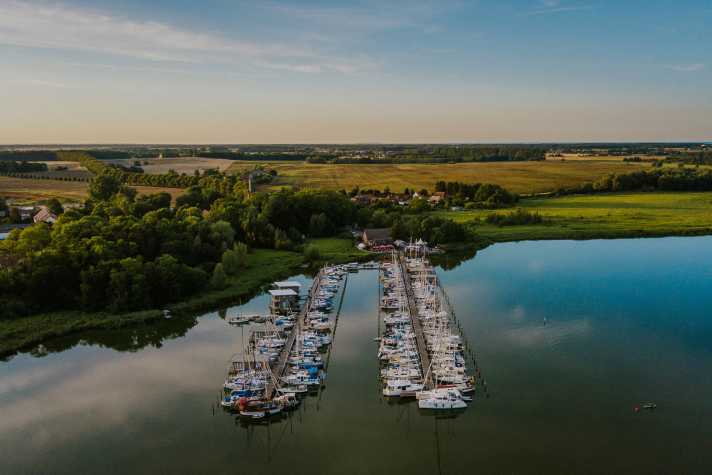
So idyllic, so remote, so lovingly designed and run as the natural harbour - you rarely find this on the Baltic Sea. Those who prefer peace and tranquillity to the hustle and bustle of life on holiday should not shy away from the usually long journey. Krummin is closer to the sea border with Poland than to the south coast of Rügen. It is a good six nautical miles from Wolgast and a similar distance from Usedom.
The route leads from Greifswald, Stralsund or Rügen via Peenemünde past many mostly well buoyed shallows. Yachts with a draught of up to 2.10 metres can pass through without any problems, even in the shallow waters of the Bodden caused by long easterly winds. The Krumminer Wiek is also a great place to sail, as it is almost always shallow close to the shore.
Above all, however, this is a place to slow down, unwind and arrive. The natural harbour with four-star comfort offers space for just 160 boats and, as the name suggests, is nestled in a natural oasis. Reed belts and old trees frame the lovingly designed grounds, making you feel as if you are far away from civilisation. The small village, with its 13th-century church of St Michael, is only a few minutes' walk to the west of the marina. There you will also find the pretty garden café "Naschkatze" or the "Pferdetränke", a farm shop and excursion restaurant serving delicious stone-baked bread.
But once you've found a berth in the natural harbour, you don't really need or want to leave. Frank Schmidt and his almost two dozen employees offer much more than just a box for the boat: since this season, the catering is open all day, seven days a week from 8 a.m. to 11 a.m. there is now a delicious breakfast, followed by selected dishes made mainly from local ingredients and grilled dishes in the evening. "We only close when the last guests leave," says the harbour operator.
The small ensemble of thatched-roof buildings houses the kitchen, harbour master's office and the finest sanitary facilities, which are among the best on the German coast. A reed hut was recently added, where guests will be able to dine under cover in future. Previously, they sat outside, protected from the sun or drizzle by a large umbrella.
Just being there, in this quietly magical place, would be relaxation enough. But happiness can be enhanced: on a canoe trip on the Wiek, for example, or on the terrace when the harbour master becomes the barbecue master. The "Little Harbour Festival" in July, where singer-songwriters perform live, is also unforgettable. Then it can be difficult or even impossible to get a free guest berth. No problem: Krumminer Wiek is so well protected from almost all wind directions with the exception of southerly that you can easily drop anchor and visit the harbour by dinghy.
Those who want to really switch off outside the sailing season can also do so here. There are six houseboats moored on the rustic wooden jetties, which can also be booked as guest accommodation during the winter. They have underfloor heating, a wood-burning stove and some also have a sauna - and enhance the experience of nature even more when the harbour is otherwise empty and the wind whistles around the wooden panelling. "This is almost the best time," says Frank Schmidt. Almost!
9th Helnæs Bugt, South Funen - Space even in the high season
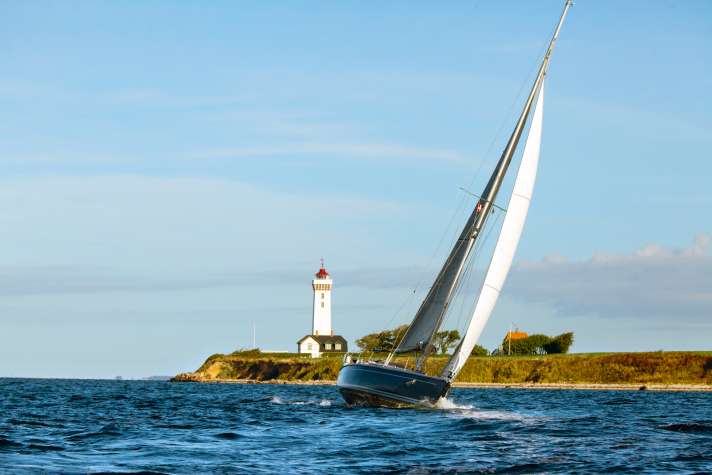
Many people have passed the landmark for this bay a thousand times: The striking Helnæs Fyr beacon (above in the photo) marks the entrance to this very wide, almost 2.5 by 5-mile incision in Funen's west coast. Nevertheless, many crews leave Helnæs Bay to the left. It almost looks like a large inland lake, surrounded by land, which only reveals its charm once inside. For example, in the form of the beautiful anchorages directly in the shelter of the small forest on the west side. In southerly winds, you simply move behind the narrow islet of Illum, on which there is only a solitary farmstead. The bay is for anchor fans looking for peace and quiet. There's not much to explore, but the small, cosy harbour of Falsled with its ice cream parlour and the "Falsled Kro". Or you can take the dinghy over to Helnæs for a tour of the island.
10 Fifång, south of Stockholm - Protected jetty in the nature reserve
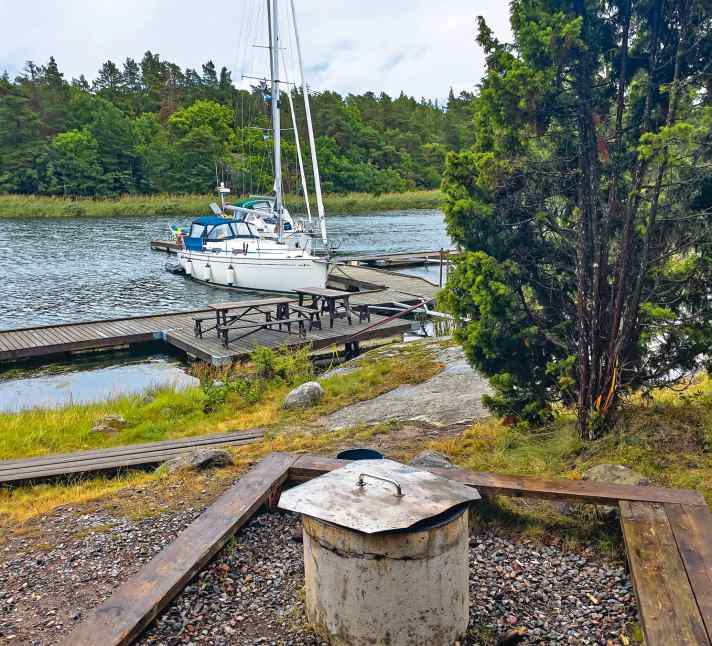
Fifång lies south of Stockholm in the mouth of the Himmerfjärden. There are several anchorages in the north-eastern inlet. And in the south of the island there is a natural harbour with several jetties in a bay hugged by a headland to the east and west. If the wind isn't blowing from the south, you'll be perfectly sheltered here. And: you will meet open, friendly people here. They maintain the harbour and the surrounding nature reserve with great sensitivity. Their efforts are worthwhile: hiking trails lead over rocks and through rustic forests overgrown with moss and lichen.
The surroundings are fabulous - the word fits here. High above the bays, the view becomes expansive and the archipelago presents itself in all its beauty. A thoroughly rewarding change of perspective, as it brings back new images for the memory. However, there is not much in the harbour itself. A barbecue area, natural toilets - that's all. And enough!

